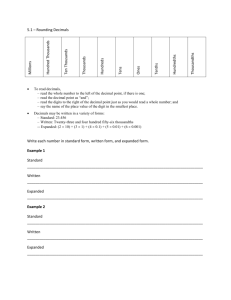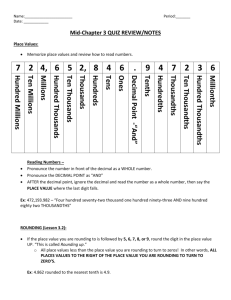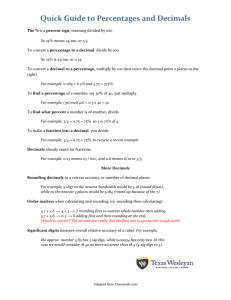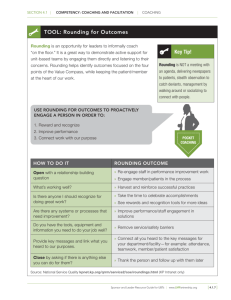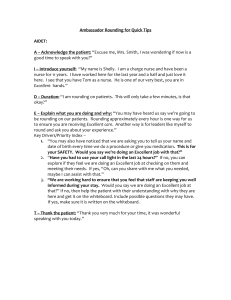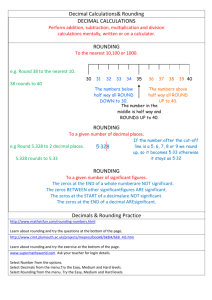The Pathwise “Instruction Plan” Design
advertisement
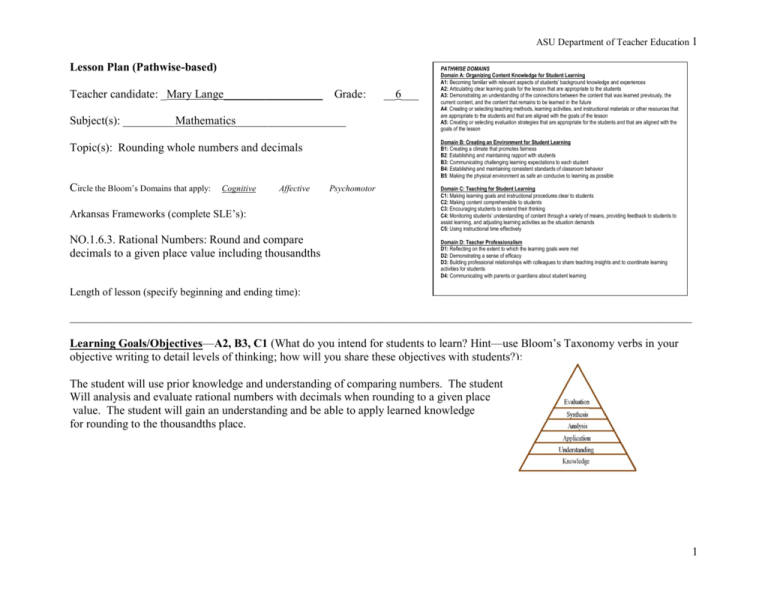
ASU Department of Teacher Education 1 Lesson Plan (Pathwise-based) Teacher candidate: _Mary Lange_________________ Grade: Subject(s): _________Mathematics___________________ Domain B: Creating an Environment for Student Learning B1: Creating a climate that promotes fairness B2: Establishing and maintaining rapport with students B3: Communicating challenging learning expectations to each student B4: Establishing and maintaining consistent standards of classroom behavior B5: Making the physical environment as safe an conducive to learning as possible Topic(s): Rounding whole numbers and decimals Circle the Bloom’s Domains that apply: Cognitive Affective Arkansas Frameworks (complete SLE’s): NO.1.6.3. Rational Numbers: Round and compare decimals to a given place value including thousandths __6___ PATHWISE DOMAINS Domain A: Organizing Content Knowledge for Student Learning A1: Becoming familiar with relevant aspects of students’ background knowledge and experiences A2: Articulating clear learning goals for the lesson that are appropriate to the students A3: Demonstrating an understanding of the connections between the content that was learned previously, the current content, and the content that remains to be learned in the future A4: Creating or selecting teaching methods, learning activities, and instructional materials or other resources that are appropriate to the students and that are aligned with the goals of the lesson A5: Creating or selecting evaluation strategies that are appropriate for the students and that are aligned with the goals of the lesson Psychomotor Domain C: Teaching for Student Learning C1: Making learning goals and instructional procedures clear to students C2: Making content comprehensible to students C3: Encouraging students to extend their thinking C4: Monitoring students’ understanding of content through a variety of means, providing feedback to students to assist learning, and adjusting learning activities as the situation demands C5: Using instructional time effectively Domain D: Teacher Professionalism D1: Reflecting on the extent to which the learning goals were met D2: Demonstrating a sense of efficacy D3: Building professional relationships with colleagues to share teaching insights and to coordinate learning activities for students D4: Communicating with parents or guardians about student learning Length of lesson (specify beginning and ending time): ___________________________________________________________________________________________________________ Learning Goals/Objectives—A2, B3, C1 (What do you intend for students to learn? Hint—use Bloom’s Taxonomy verbs in your objective writing to detail levels of thinking; how will you share these objectives with students?): The student will use prior knowledge and understanding of comparing numbers. The student Will analysis and evaluate rational numbers with decimals when rounding to a given place value. The student will gain an understanding and be able to apply learned knowledge for rounding to the thousandths place. 1 ASU Department of Teacher Education 2 Considering Prior Knowledge –A1, A3 (What Prior Knowledge of this concept/topic/skill do the students have? Knowing this will help you effectively use existing schema or to develop background knowledge) The student should be able to compare and round whole numbers to a given place value. The student should also be familiar with place value to the right of the decimal, i.e. tenths, hundredths, thousandths. Student Grouping—B1, B4 (How will you group students for instruction and WHY did you choose the group members/partners or the process you did?): The students are already in assigned seats. The students were separated by gender with a pair of each sitting in the quad style desk arrangement. Two students sit individually to allow for maximum attention during instruction. Teaching Methods—A4, C4, C5 (Decide on the model(s) or strategy(ies) you are using, write it/them down, and write why you chose it/them: To begin with, question and answer is the best strategy. The teacher will ask questions of the students to see what depth of knowledge they have retained. Then once the base has been established, direct instruction would be the next strategy for teaching. Drill and practice would take place after the base was established and the new material had been covered. Lesson Description/Activities—A3, A4, B4, B5, C1, C2, C3, C4, C5 (Describe how you will enact this lesson and the methods involved. Ensure a logical sequence. Be sure to be so detailed that someone could enact the lesson without you there. Write down your actions, what you will say, transition statements, and be sure to include a motivational opener and a closure!) 1. Introduction: state objectives, activate background knowledge and experiences, engage learners, connect previously learned content Projected Time: _10min___ The main objective for this lesson is to round to the thousandths place. We will begin with prior knowledge of rounding whole numbers and place value. Rounding whole numbers, first the given number 978, will be rounded to the nearest ten. The answer is 980. A few more examples will be given if needed. Prior knowledge about place value will be reviewed as well(hundrends, tens, ones . tenths, hundredths, thousandths) 2 ASU Department of Teacher Education 3 2. Lesson Procedures: demonstrate, model, facilitate inquiry and exploration, provide rehearsal of content, explain and enact cooperative group procedures, detail strategy procedures, note writing time or reading time, presentations and sharing Projected Time: __15__ At this time I would demonstrate that rounding on the right side of the decimal is just like rounding whole numbers. When rounding, the number to the right of the designated number determines the rounded number. If the number is five or larger, then it causes the designated number to move up one. If the number to the right of the designated number it is four or smaller, the designated number stays the same. Example: 152.4612 =152.461, 98.3335=98.334, 1.2209 = 1.221 More examples would be given via story board. The students are then given ten problems on the last page of story board to work. The students are asked to give the correct answer. Individual students are asked to give the answer to a problem and to explain how they got the answer. If the answer is wrong, the answer will be given and it will be explained how the answer was produced. 3. Closure: Connect to future learning, encourage further questioning, reflect on discoveries, place new knowledge in authentic context, check for understanding Projected Time: _5___ The lesson of how to round to the thousandths place will be given again. It will be connected to rounding whole numbers. 4. Extensions: websites to explore, questions to research, establishing new inquiries, additional applications The students will be given another work sheet to complete at home. It will include rounding of whole numbers as well as numbers the right of the decimal. There will be a few numbers for rounding to the ten-thousandths and hundred-thousandths to test the students knowledge of rounding. Materials and Technology—A4 (List the instructional materials you will use, including books, handouts, websites, & texts. Use of technology is encouraged, so be sure and list everything you need to integrate it such as flash drives, laptop, projector, flipcam, etc) Materials needed: books, pencil, paper, flash drive, whiteboard, dry erase marker, projector screen. 3 ASU Department of Teacher Education 4 Assessment (How and when do you plan to assess student learning on the content of this lesson? Be sure your assessments align with the objective(s). Rubric, checklist, exit slip, quiz, discussion, anecdotal records, peer assessment, self-assessment, written feedback on student work, test [type & purpose], written response, group analysis Informal and/or Formal [formative] [summative] I will use informal assessments during class when I ask the students questions about how they determined how to round the designated number. A formal assessment would take place with the take home sheet. The student will receive a homework grade for this. Modifications or Accommodations for Special Needs students if present (describe IEP requirements) or for Diverse Audiences (What aspects of culturally responsive pedagogy, multicultural education, or adaptations for English language learners did you address in this lesson)? Kinesthetic learning activities, visuals, contextualizing, peer assistance, scaffolding, comprehensible input, active involvement, interactive goal-setting, authentic assessments IEP>The Student needs extra time for assignments. The Student needs to sit at the front of the classroom. The students are in quad desks which allow of peer assistance. The students are encouraged to assist each other and are given verbal praise if they do so. They also remind each other to behave and to not cause disruptions during class time. The students are actively involved during the learning process so that they have a full understanding of the material and are able to apply and evaluate it as well. 4
